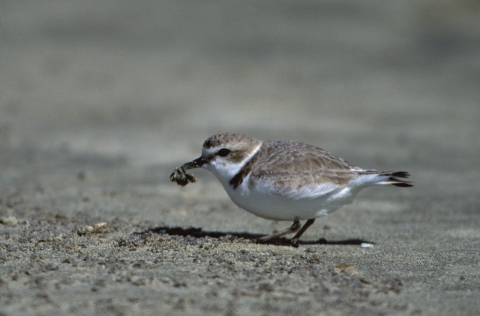The snowy plovers of Doran Beach noticed something different about 2020. Where had all the humans gone? Where were the dogs, often off-leash and coming too close? Where was the noise, the vehicles? For the first time in the Doran Regional Park’s 50-year history, the beach was empty. One pair of plovers saw in that empty beach a little patch of sand that looked perfect, and they laid eggs.
While humankind was under COVID lockdown, wildlife responded positively to the change. For years, snowy plovers have been overwintering at Doran Beach, an area of Doran Regional Park in Sonoma County, but the nesting behavior of 2020 was a welcome surprise. Now that the crowds have returned, Sonoma County Regional Parks is working to keep the beach an appealing and safe site for both overwintering and nesting plovers.
Unfortunately, the chicks in the first nest didn't survive, and invasive plants are partially to blame.
“When plover chicks are getting ready to hatch, they start peeping within their eggs and talking with their parents,” said Len Mazur, a botanist with Sonoma County Regional Parks. “A native predator, possibly a skunk, heard the peeping from within the unhatched eggs and was able to sneak in and take them because of the cover provided by the European beachgrass up the shore.”
A glance up the shoreline shows how extensively the tall, invasive bunch grass has taken over the dunes at the park. It grows taller and more densely than its native counterpart, American dunegrass, and it’s just about the only thing that can compete with the equally invasive ice plant that grows in thick mats on the dunes. The native ecosystem has been disrupted, creating challenges for the native plant community and plovers alike.
That’s changing this year.
In 2018, a joint project was launched between Sonoma County Regional Parks and the California Native Plant Society to remove invasive plants from the Doran baylands. When that project area was finished, the effort spread to other parts of the park.
“At the time, we were focused on preserving the Point Reyes bird’s beak that grows in the baylands,” said Jan Lochner, co-chair of the invasive plant committee for the Milo Baker Chapter of the California Native Plant Society. “Now, we’re working with Sonoma County Regional Parks on a project to rehabilitate the dunes here at Doran Beach.”
Every Wednesday, about fifteen California Native Plant Society volunteers clear out the European beachgrass and ice plant from a new section of the dunes. While the vast coverage of invasive plants that must be removed from the beach looks intimidating, the progress has been steady, and luckily, both the ice plant and the beachgrass are relatively easy to hand-pull in clumps from the sand.
“The hardest part has been figuring out where to stack everything we pull,” Lochner said with a laugh, referring to the dumpster trailer filled to the brim with vegetation.
Nearby piles grow by a couple feet every time a volunteer dumps their bucket. The plant matter is dried in neat piles on-site and eventually made into compost by the county.
Once a section of the dunes are cleared, volunteers and park staff are giving native plants a jumpstart.
“Funded by a small grant from the U.S. Fish and Wildlife Service’s Coastal Program, we’re planting native plants that have been grown for us over the last year by the Laguna Foundation,” said Minona Heaviland, park program supervisor in the natural resources division of Sonoma County Regional Parks.
After applying for and receiving the grant from the Service, park staff and California Native Plant Society volunteers joined the Laguna Foundation last year to collect the native seeds and vegetative samples that will form the foundation of the native plant community in the Doran Beach dunes. American dunegrass, seaside daisy and yellow sand verbena are just a few of the species being planted.
“The native plantings will create an ecosystem that is a more diverse and dynamic habitat for snowy plovers,” said Bridget Giblin, biologist in Sacramento Fish and Wildlife Office’s Coast-Bay Division. “Now that native plants can be restored to the area, the plovers will have a habitat that provides for better foraging and nesting sites. We hope this will encourage more plover activity at this site in the future.”
Determined individuals of both the Milo Baker chapter of the California Native Plant Society and Sonoma County Regional Parks have carried the torch for the project forward, believing in the vision of a restored ecosystem.
“We’re looking for opportunities to bring in more partners and stack the benefits of everything we’re accomplishing,” said Mazur. “This is true DIY, homegrown conservation.”
Visitors to Doran Beach can help snowy plovers and other wildlife by keeping dogs on leash at all times and giving wildlife space.



